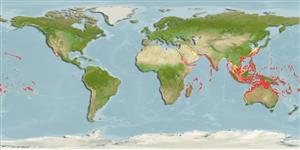Common names from other countries
Environment: milieu / climate zone / depth range / distribution range
Ecologia
marinhas associadas(os) a recifes; intervalo de profundidade 1 - 113 m (Ref. 90102). Tropical; 33°N - 34°S, 32°E - 109°W
Indo-Pacific: Red Sea, East Africa, Comoro Islands and Mascarenes, east to the Hawaiian Islands, Line Islands and Pitcairn Group, north to southern Japan, south to Joseph Bonaparte Gulf (northern in front of Western Australia), New South Wales (Australia), Lord Howe, Norfolk, Kermadec Islands, New Caledonia, Tonga and Gambier Islands (Ref. 86817). Reported from Easter Island (Ref. 89467). Records from Eastern Pacific in Mexico and Panama need further confirmation.
Comprimento de primeira maturação / Tamanho / Peso / Idade
Maturity: Lm 24.0, range 21 - ? cm
Max length : 39.8 cm FL macho/indeterminado; (Ref. 125599); common length : 25.0 cm TL macho/indeterminado; (Ref. 30573); peso máx. publicado: 1.1 kg (Ref. 125599)
Espinhos dorsais (total) : 8; Raios dorsais (total) : 9; Espinhos anais: 1; Raios anais : 7. Back red-orange, sides and belly whitish; yellow longitudinal band present; no dark blotch on under middle of 1st dorsal fin (Ref. 5405). All fins yellow (Ref. 48636). Head length 2.9-3.4 in SL, length of snout 2.2.-2.6 and barbel 1.2-1.5 in HL. Body depth 3.4-4.5 in SL. (Ref. 90102)
This occasionally schooling species inhabits sandy bottoms of reef flats, lagoons, coastal and seaward reefs (Ref. 9710, 90102). Benthopelagic (Ref. 58302). In large inactive aggregations by day, dispersing to sand flats to feed at night (Ref. 9710). Sometimes mixes with blue-striped snapper Lutjanus kasmira and shows blue stripes (Ref. 48636). Feeds on small worms and crustaceans. Also caught using ringnets (Ref. 5213). Minimum depth reported taken from Ref. 30874.
Ciclo de vida ou comportamento de acasalamento
Maturities | Reprodução | Spawnings | Egg(s) | Fecundities | Larvas
Myers, R.F., 1991. Micronesian reef fishes. Second Ed. Coral Graphics, Barrigada, Guam. 298 p. (Ref. 1602)
Status na Lista Vermelha da UICN (Ref. 130435)
CITES (Ref. 128078)
Not Evaluated
Ameaça para os humanos
Harmless
Uso pelos humanos
Pescarias: espécies comerciais; peixe esportivo: sim
Ferramentas
Relatórios especiais
Baixar XML
Fontes da internet
Estimates based on models
Preferred temperature (Ref.
115969): 24.3 - 28.9, mean 27.7 (based on 1376 cells).
Índice de diversidade filogenética (Ref.
82804): PD
50 = 0.5078 [Uniqueness, from 0.5 = low to 2.0 = high].
Bayesian length-weight: a=0.01023 (0.00888 - 0.01180), b=3.09 (3.05 - 3.13), in cm Total Length, based on LWR estimates for this species (Ref.
93245).
Nível Trófico (Ref.
69278): 3.9 ±0.44 se; based on food items.
Resiliência (Ref.
120179): médio(a), tempo mínimo de duplicação da população 1,4 - 4,4 anos (K=0.20-0.97).
Fishing Vulnerability (Ref.
59153): Low vulnerability (24 of 100).
